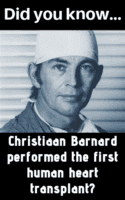Christiaan Barnard was a South African heart surgeon who performed the first human-to-human heart transplant. Together with his crew of medical professionals the operation took place in Groote Schuur Hospital, Cape Town in December 1967.
Louis Washkansky, who underwent this ground-breaking surgery, was a 53-year-old suffering from a heart condition. After the operation, Washkansky was able to talk to his wife and sometimes go for a walk. Sadly he died 18 days after the transplant from pneumonia. The donor heart that Washkansky received was from Denise Darvall, a 25-year-old victim of a road accident.
Barnard said in an interview with Time Magazine that: “The heart transplant wasn’t such a big thing surgically. The technique was a basic one. The point is I was prepared to take the risk. My philosophy is that the biggest risk in life is not to take a risk. The operation and its significance as the first of its kind took me into another world, not just professionally but personally and socially. I loved it.”
The first heart transplant also shed a major spotlight on South Africa. The story was a global one and Barnard received multiple awards including the Dag Hammarskjold International Prize and Peace Prize, the Kennedy Foundation Award and the Milan International Prize for Science. Barnard was also considered for the Nobel Peace Prize, but unfortunately never received it.
Although Barnard became famous internationally and won many awards, one tends to forget that there was a whole team of individuals that helped to make this surgery a success in the operating theatre and behind the scenes. One of these individuals was Hamilton Naki.
Hamilton Naki was born in Ngcingwane, a village in the Eastern Cape. His family was poor and he received six years of education up to the age of 14. When he left school he moved to Cape Town where he lived in Langa township and got a job as a gardener at the University of Cape Town.
Dr Robert Goetz, a doctor at Groote Schuur hospital who had come into contact with Naki, asked him to assist him in a new surgical laboratory. He started by cleaning the animal cages and then learned to anaesthetise dogs, rabbits and even a giraffe for research purposes. He became the laboratory assistant to Christiaan Barnard and was made principal surgical assistant of the laboratory where he taught many medical students and doctors his skills. Barnard said: “If Hamilton had had the opportunity to study, he would probably have become a brilliant surgeon. And that Naki was: “One of the great researchers of all time in the field of heart transplants.”
Despite this, when he retired he only had a gardener’s pension and was only recognised for his medical work after his death, when he received The Bronze Order of Mapungubwe – an award to South African citizens for excellence and exceptional achievement. He was also given an honorary master’s degree from UCT.
The story of this remarkable time in medical history is kept alive in The Heart of Cape Town Museum where Theatres A and B that, were used for the heart transplant operation, have been recreated as they were when the operation was done all those years ago.
If you ever have the opportunity to visit Cape Town, or if you are lucky enough to live in Cape Town, then you should definitely make a plan to take a tour of the museum to experience this part of medical history for yourself.
Tell us: What was the most interesting fact for you about Christiaan Barnard and Hamilton Naki?


